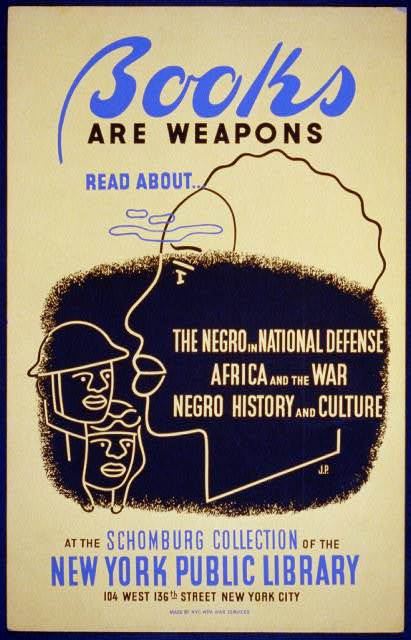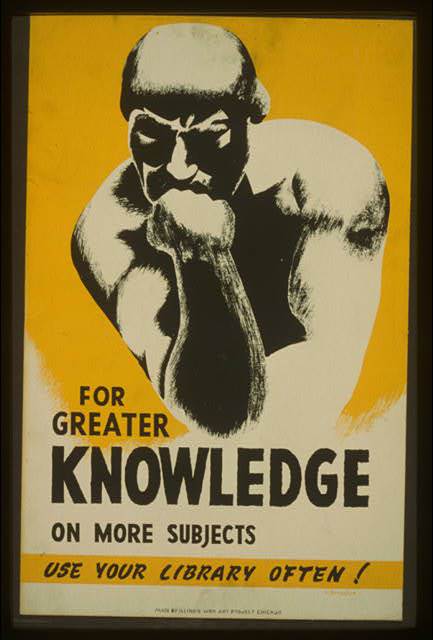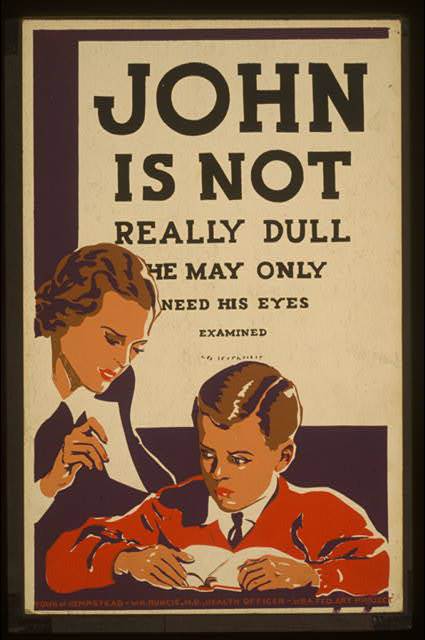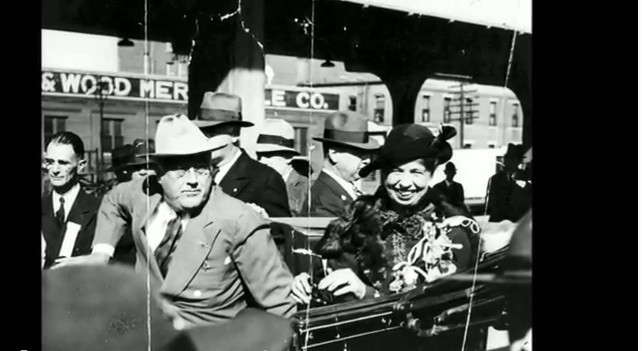While working on his Ph.D dissertation, Mark Barron has pulled out some great stories from his research to share with the Living New Deal. Enjoy:
While conducting research in my hometown of Marietta, GA for an upcoming dissertation that looks at metropolitan politics in the 1930s and 1940s, I was reminded of the intersecting qualities education and employment play in the lives of young people. Taking a break from scouring local archives, I spent a spring morning hiking the trails of Kennesaw Mountain National Battlefield Park. I grew up in the shadow of the mountain and learned the site’s local history at a young age – both as a place of battle during the Civil War and as a former campsite for the Civilian Conservation Corps (CCC) in the late 1930s. It is that latter history that always seems to resonate with me when I get the chance to revisit the miles of trails that wind though the park – most of which were cut by CCC workers over seventy years ago. I am certainly not alone in enjoying the labors of those who enrolled in the camp during the New Deal. Each year, the park has an annual visitorship of over a million persons.

Camp members at Kennesaw Mountain placing a cannon to aid in the historical interpretation of the park (date unknown).
While many of us are familiar with the story of how the corps put young men to work on lands owned by federal, state, and local governments, the role the program played in educating those who served in its ranks is a surprise to many. At the Kennesaw Mountain camp, for instance, the CCC had a remarkable success rate in giving its young men the equivalent of a high school education, as well as offering them instruction in woodworking, agricultural science, and automotive mechanics. The emphasis placed on providing camp enrollees with a basic education supplemented with vocational skills was an important objective in the CCC’s tenure. The history of education at Marietta’s camp was not necessarily exceptional in these regards, but documents found in the National Archives and the recollections of former enrollees do help illuminate how the CCC enacted education policy into its program and demonstrates the ways in which the policy benefited the camp’s volunteer enrollees.
The CCC established Camp NP-4 at Kennesaw Mountain in June of 1938. [1] Though the National Park Service had obtained the site from the War Department a few years earlier, little to no infrastructure improvements had been made to the site located approximately 20 miles northwest of Atlanta. Originally consisting of a handful of supervisors and enrollees housed in military surplus tents, the campsite steadily grew over the next two and half years into its own mini-city, with barracks, mess hall, recreation center, library, and educational facility designed to serve its full complement of 225 young men. Early project reports for the camp indicated that its primary focus was to involve road construction, fire suppression measures, erosion control, tree planting, and seed collection. [2] Over the course of the camp’s tenure, however, its mission came to include constructing a park headquarters and providing guided tours to interested visitors, locals and dignitaries alike. Enrollees received 30 dollars a month, with 25 dollars of that amount going to their families back home.
As was common with CCC sites, Camp NP-4 was racially segregated with enrollment limited to whites only. [3] Yet even within the ranks of its all white volunteers, the camp was socially diverse. Because the CCC offered good wages to unemployed young men, enrollees came from nearby cities, as well as from farms, with members of both groups demonstrating varied skills in regards to their educational abilities. In Georgia during the 1930s, public schools only operated on an eleven year system, with college-bound students often having to take additional, privately-funded courses prior to entering a university. For young adults from the state’s urban areas, an eighth grade education was often the accepted norm for someone planning to enter into an industrial-type position at a textile mill or furniture factory. Within farm families, however, the level of education acquired at the time adulthood varied greatly. Throughout Georgia, most rural schools only operated on a seventh month academic calendar – a recognition of the importance farming responsibilities played in rural communities. Many farm children, including those found in the countryside around Marietta, may have only received an elementary level education, if that. [4]
The organization of the CCC began in the early days of Roosevelt’s presidency and constituted a key component of FDR’s plan to put Americans back to work. From the very beginning, CCC officials acknowledged the educational discrepancies of its enrollees. Looking back on the formation of the CCC and other New Deal programs a few years prior, a 1941 symposium on reading skills in America highlighted the problems federal programs and agencies faced upon entering the southeast. An “overwhelming percentage of [the country’s] illiteracy is found in the South, where the schools are often destitute,” stated the symposium’s published remarks. [5] Indeed, even though New Deal money had erected or improved school buildings across Georgia, county and municipal governments often faced hardships in finding money for operating costs and teachers salaries. In many public school systems, including Marietta, students had to purchase their own textbooks. [6] As the CCC expanded its enrolled workforce during the Great Depression, its director noted that nation-wide, up to five percent of the young men who joined the CCC “were totally unable to read or write” upon first entering the corps, with a “much higher percentage” having very limited literacy skills. [7]
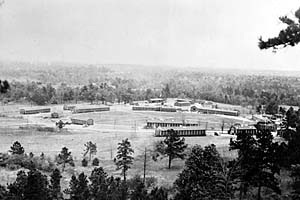
Aerial view of CCC camp from atop Kennesaw Mountain (date unknown).
In an effort to combat its illiteracy problem, the CCC initiated a tiered educational evaluation of its enrollees. Realizing that some may have no ability to read or write, while others may have only marginal skills, the CCC created the term “functional illiteracy” to describe those in the latter category. Based on the number of school years a person completed and an assessment of their educational skills, the CCC designated that “functional illiteracy” described a person who had completed no more than three years of school. A designation of “illiteracy,” conversely, was given to individuals with less than three years of formal education. [8] By the mid to late 1930s, CCC camps across the country were submitting “educational reports” to the director’s office in Washington, D.C.
The education reports from the Kennesaw Mountain camp illustrate the positive effects of the CCC’s commitment to education. By the end of 1938, some six months after first opening, 140 young men of the camp’s complement were attending night classes five times a week in academic subjects such as literacy, history, arithmetic, penmanship, and spelling. Where many public schools were still struggling to fill teacher positions, the CCC brought in instructors from the WPA to conduct its courses. Additionally, the Kennesaw Mountain camp offered vocational classes and job training courses to prepare enrollees for futures outside of the CCC. In an effort to keep its enrollees engaged in academic pursuits, the camp featured a library stocked with 871 volumes comprised of books, magazines, and daily newspapers. At the end of the 1938 report was an astonishing claim. “All illiterates are enrolled in courses and are making satisfactory progress. The number of illiterates in this company has been reduced from sixty-five to eleven.” [9]
Two years later, the camp’s education reports continue to show the progress of the CCC’s literacy campaign. By June of 1940, for instance, all but one enrollee could read and write. In the September report of that year, the library had grown to well over 900 volumes, with the camp stating that sixty percent of its company could read books, with all enrollees being able to read at least a magazine or newspaper. In the “results of educational work” section of the report, the filing administrator notes that “enrollees are leaving camp as better citizens, some as semi-skilled craftsmen and others have been instructed in new and efficient methods of farming.” “All enrollees,” the field report continued, “are receiving basic academic training up to and including the eighth grade.” Three members of the camp’s company had even decided to continue their high school education to the eleventh grade level and the report noted that they would graduate within a year. [10]
Once the United States entered World War Two, many of the Kennesaw Mountain camp’s enrollees either entered the service or went to work in the defense industries. In either respect, the young men who labored and studied with the CCC took their newfound knowledge and skills with them. Oral history interviews from World War Two veterans, for instance, often discuss the impact vocational and education classes from the CCC and other New Deal programs such as the National Youth Administration (NYA) had in helping them complete their military service. In 1942 and 1943, the War Department constructed an aircraft assembly plant in Marietta, GA, where people with experience in mechanics, such as were taught within the CCC, were in great demand. Many of those employed in the defense industry would later work at Marietta’s Lockheed assembly plant or at Atlanta’s expanding civil airport.
After the war, the effects of an education acquired from the CCC continued to resonate with its former enrollees. At a fiftieth anniversary camp reunion for NP-4 held at Kennesaw Mountain in 1988, a former member of the company recalled arriving at the camp at seventeen years of age with “no job and no money.” “I got…experience out of this,” the man said, going on to discuss how he went on to work for, and eventually retire from, Lockheed’s aircraft division. Another of the camp’s company remembered spending nearly four years with the CCC at Kennesaw Mountain, re-enlisting every six months to continue studying stonemasonry. “I would have stayed longer if I could,” he said, “but the CCC helped me and I got good jobs afterwards.” [11]

Morning flag raising at Kennesaw Mountain CCC camp (date unknown).
As we enjoy the products of CCC labor in our visits to parks across the country, it is good to remember that the New Deal did more than affect the physical landscapes of our communities; it shaped the lives of its workers and their descendants. The CCC through its education policy filled a void that was not being met by traditional methods. The enrollees of CCC Camp NP-4 not only learned valuable skills that influenced their future careers and livelihoods, they also extended the benefits of a good education onto their children, many of whom probably went to college thanks to the “helping hand” the New Deal gave their parents in the late 1930s and early 1940s.
[1] The camp was initially designated NM-3 in 1938, but was changed shortly after to NP-4.
[2] “Work Project Supplementary Report, November 15, 1938”; Camp Inspection Reports/ GA-Marietta, NP-4; Records of the Civilian Conservation Corps, Record Group 35/ Box 47; National Archives at College Park, College Park, MD.
[3] More information on the segregation policy of the CCC can be found online at https://newdeal.feri.org/aaccc/index.htm and in Olen Cole Jr., The African American Experience in the Civilian Conservation Corps (Gainsville: University of Florida Press, 1999).
[4] Georgia’s public education system in the 1930s is discussed in an oral history interview with a former principal of Marietta High School. Cobb County Oral History Project, Shuler Antley, Interview conducted by Thomas A. Scott, 25 October 1978. Georgia Room, Cobb County Public Library.
[5] “What Shall We Do About Reading Today? A Symposium,” The Elementary English Review, Vol. 19, No. 7 (November 1942), 242.
[6]Cobb County Oral History Project, Shuler Antley, Interview conducted by Thomas A. Scott, 25 October 1978. Georgia Room, Cobb County Public Library.
[7] “What Shall We Do About Reading Today? A Symposium,” The Elementary English Review, Vol. 19, No. 7 (November 1942), 241.
[8] In World War Two, the United States military adopted the CCC’s educational assessment program. John Folger and Charles Nam, Education of the American People. United States Department of Commerce (1960), 126.
[9] “CCC Camp Educational Report, November 17, 1938,” Camp Inspection Reports/ GA-Marietta, NP-4; Records of the Civilian Conservation Corps, Record Group 35/ Box 47; National Archives at College Park, College Park, MD.
[10] “CCC Camp Educational Report, June 11, 1940 & September 9, 1940,” Camp Inspection Reports/ GA-Marietta, NP-4; Records of the Civilian Conservation Corps, Record Group 35/ Box 47; National Archives at College Park, College Park, MD.
[11] All quotes taken from “Eyes Sparkle at CCC Camp’s Reunion,” Marietta Daily Journal, 2 October 1988.
****
Mark Barron is a Ph.D. candidate in American Studies from the University of Maryland, College Park. He presently resides in Pasadena, CA.










